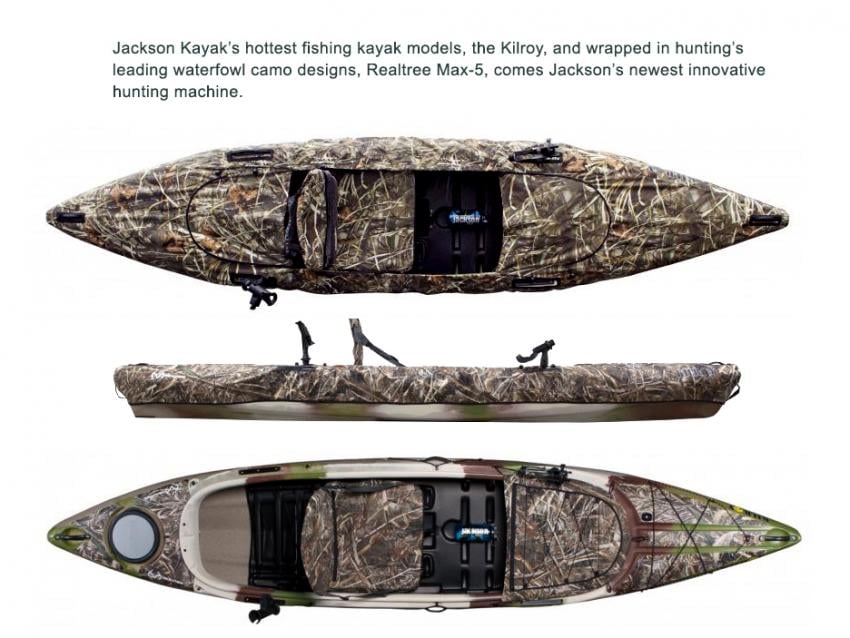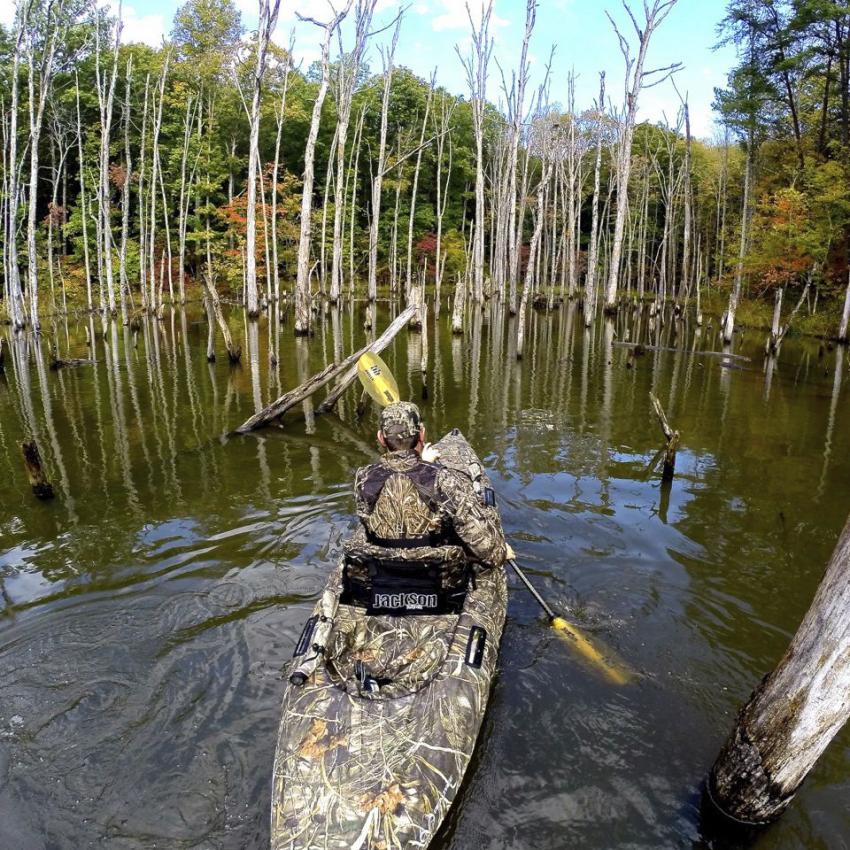Jackson Kayak and Realtree Camo: A Natural Fit
- June 23, 2016
- By Brian Lovett
- Products

The folks at Jackson Kayak never look far when determining how to stay ahead of the pack. That makes all the difference.
“The bottom line is that we never look to our competition to see what they are doing,” said James McBeath, marketing director for Jackson Kayak, a Sparta, Tennessee, company that designs and builds state-of-the-art whitewater, fishing, hunting and exploration paddlesports products. “We solve problems that we find sitting right in front of us as we fish in kayaks. All our decisions are being made on how to better both the performance of the kayak and the logistics of fishing. Fishing kayaks designed by folks actually fishing from them — that’s our past, present and future.”
Jackson Kayak, founded in 2003 by Eric Jackson and Tony Lunt, has partnered with Realtree for three years and currently offers three models in Realtree camo: The Cuda LT Realtree Hardwoods HD, a maneuverable 12-foot sit-on-top kayak for small to medium lakes and rivers (LT stands for lightweight and thermoformed); and the Realtree Kilroy and Realtree Kilroy LT, in Max-5, which are sit-inside kayaks designed for fishing and waterfowl hunting, and include storage for a gun, ammo and decoys.



“Camo on kayaks is definitely unique,” McBeath said. “Still today it is logistically difficult to do camo on a kayak without wrapping it. There are a few manufacturers who do simple camo, but not a lot do complex camo other than decals and mini wraps.”



McBeath said the popularity of kayak fishing began to increase about 10 years ago, as people wanted to get closer to fish and access areas conventional boats can’t.
On or about that time, the U.S. economy started to take hits, and the idea of managing expensive bass boats gave way to getting into a kayak. The kayak was seen as a remedy to not giving up the sport fishermen love. The same is happening to hunting to some extent. Hunters are not necessarily in the same economic situation, as hunting doesn’t necessitate a bass-boat-size expense, but the ability for hunters to get to new grounds off the beaten path is attractive. Deeper into the marshes is where you find more ducks, beyond the reach of even a small motor boat. The silence is key as well.
Of course, Jackson wasn’t the only paddlesports company to latch onto the kayak fishing and hunting craze. It’s become a competitive market — one Jackson has owned through passion and innovation.
“When we came to the fishing market, our competitors were stuck in the groove of a fast-growing sector,” McBeath said. “They were a bit complacent. Our first fishing kayak completely innovated over any existing kayak out there. We solved problems. The Coosa became one of the best-selling kayaks in the world for fishing in its first year, but it was for rivers mostly — our comfort area, if you will, being whitewater folk.”
The next year, McBeath said, Jackson released the Cuda to a market starving for a fishing kayak that could handle larger water. That model also solved the issues of windage, gear storage and, most important, kayak performance. The year after that, Jackson recognized that enthusiasts want to kayak with their children, so it offered a tandem kayak that converts to a solo model.
As the fishing/hunting kayak trend grew, marketing also became more complex. Jackson solved that by putting its unique spin on brand messaging, and it did so from within.
“Funny that we have never really been a traditional marketing force,” McBeath said. “I come from the content-is-king era in web marketing, and that’s where we naturally have gone. The good news is that the company, led by Eric Jackson, metaphors perfectly the style of marketing that combines content marketing with social media marketing. E.J. has always had a large community following him, both literally and figuratively. We have built a community surrounding E.J.; his family that extends to our team and their friends. We aren’t pro athletes with fancy shirts. We’re a groovy, fun-loving paddlesports community who everyone wants to hang out with and fish, hunt and run rapids with.
"I do the same thing online. We’ll take 150 stories a month and spin them out there to our community so that they can all live vicariously with us in our adventure lifestyle. End result, we are the single largest paddlesports media on the web. Our traffic now is higher than most of the kayak angling media combined. We post to our website or magazine websites and then use the full power of social to broadcast the posts.”
That community model also creates a natural but massive communication chain between Jackson and its customers.
“There are two targets for feedback: our consumers and our team,” McBeath said. “The good news is that our community model has made us very approachable. We paddle every day with our consumer. There is no separation. We design based on feedback we get from paddling with our market. A good quote: ‘If you are an intermediate/advanced whitewater kayaker, you have most likely met Eric Jackson.’ This statement is our marketing rallying point and the source of where we get our next kayaks. Our team is used heavily to get into the details of our product solutions. They help us find ways around the everyday issues facing kayakers of all kinds.”
And that sense of family makes Jackson an ideal partner for Realtree, a company with similar ideals.
Today’s new kayak heroes are hunting boar, bowhunting gar and stalking moose out of a kayak. Going back to their everyday life, these accomplishments — arguably no different than hunting by foot or jon boat — are seen as a step up.
